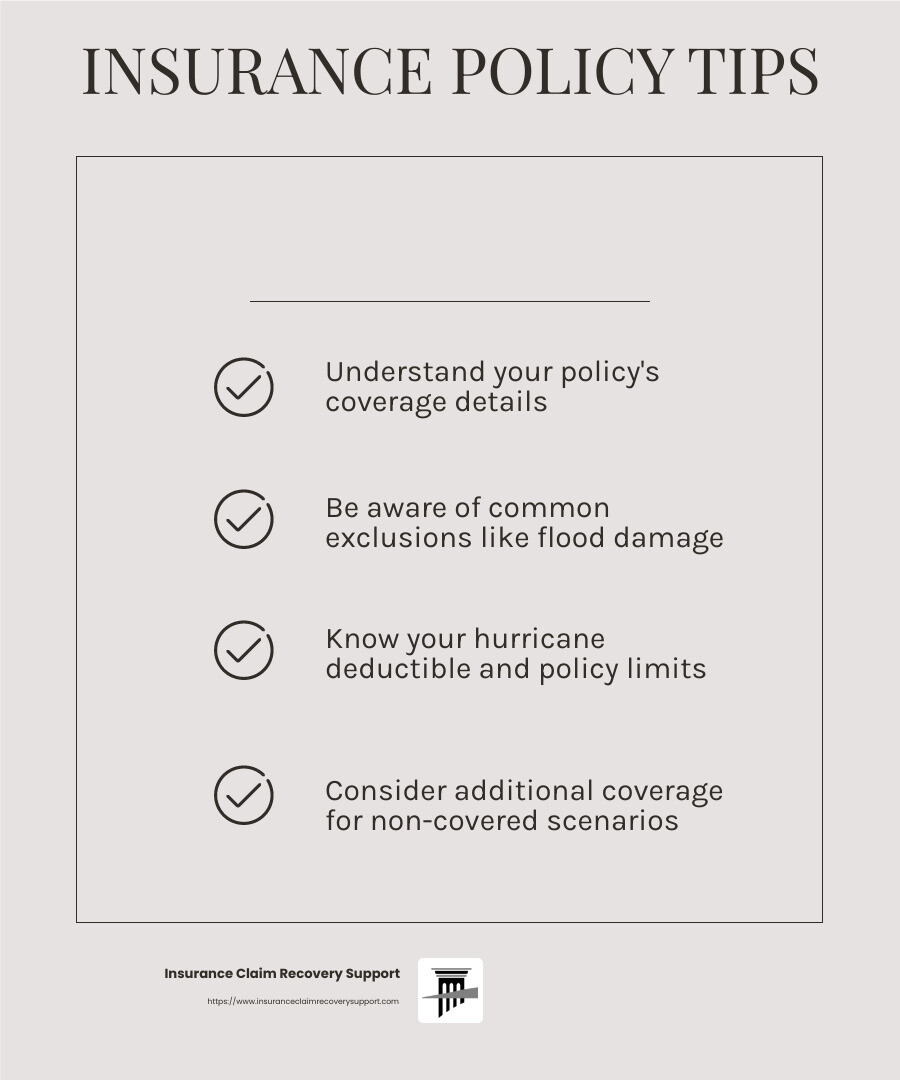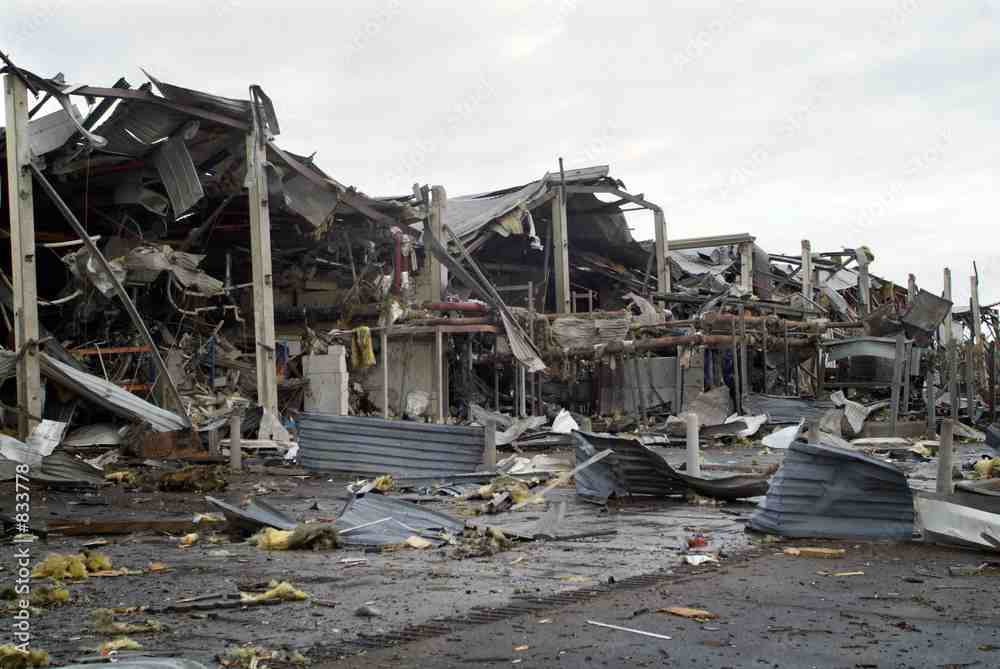Hurricane damage claims can be daunting, but filing them properly is crucial for a fair settlement. If you’re a policyholder recovering from a hurricane’s wrath, here’s a quick guide:
- Notify your insurer immediately.
- Document all damage with photos and videos.
- Review your insurance policy for coverage details.
- Submit your claim promptly, ideally within 48 hours.
Hurricanes like Harvey and Laura have taught us the importance of understanding the insurance process. As a policyholder, know what is covered and what steps to take when filing a claim. This guide will solve the complexities of the insurance claims process, helping you steer the problems with ease.
In my role as Scott Friedson, CEO of Insurance Claim Recovery Support LLC, I’ve helped countless businesses and homeowners secure substantial settlements for hurricane damage claims. With my background as a multi-state licensed public adjuster, I understand the intricacies involved and am here to simplify the process for you.

Hurricane damage claims vocab to learn:
– denied hurricane damage insurance claim
– underpaid hurricane damage insurance claim
Understanding Your Insurance Policy
Before diving into hurricane damage claims, understand your insurance policy’s coverage details, exclusions, and policy limits. This knowledge empowers you to file claims effectively and avoid unexpected surprises.
Coverage Details
Your insurance policy outlines what types of damage are covered. Typically, standard homeowners insurance will cover some wind-related damage from hurricanes, like shingles blown off a roof or tree branches breaking windows. However, it often doesn’t cover flooding caused by hurricanes. For that, you’ll need a separate flood insurance policy.
In hurricane-prone areas, policies might include a hurricane deductible. Unlike standard deductibles, which are a fixed dollar amount, hurricane deductibles are a percentage of your home’s insured value. For instance, if your home is insured for $200,000 and your hurricane deductible is 3%, you’d pay $6,000 out of pocket before insurance kicks in.

Exclusions
Knowing what your policy doesn’t cover is just as important. Common exclusions in homeowners insurance include:
- Flood Damage: Not typically covered; requires separate flood insurance.
- Windstorm Damage: In some states, you might need additional windstorm insurance.
- Business Interruption: If you run a business from home, standard policies might not cover lost income due to hurricane damage.
These exclusions emphasize the need for additional coverage in certain scenarios. For instance, businesses might need separate policies for commercial vehicles or equipment breakdown.
Policy Limits
Think of policy limits as a cap on how much your insurer will pay for a claim. It’s like an all-you-can-eat buffet with a limit on the amount you can actually consume. Understanding these limits helps set realistic expectations for your claim’s outcome. If your hurricane damage exceeds these limits, you’ll be responsible for the difference.

In summary, familiarize yourself with your insurance policy’s coverage, exclusions, and limits. This knowledge not only aids in filing a hurricane damage claim but also in ensuring you’re adequately protected before disaster strikes.
Next, we’ll explore how to document hurricane damage effectively, ensuring your claim is backed by solid evidence.
Documenting Hurricane Damage
Proper documentation is crucial when filing hurricane damage claims. It helps ensure that you get the compensation you deserve. Let’s break down the essential steps:
Photo Evidence
Start by taking clear photos of all damaged areas. Use both wide shots for context and close-ups for detail. Capture everything from exterior damage, like missing shingles, to interior issues, such as water stains on ceilings. Videos are also valuable; they provide a comprehensive view and can help adjusters understand the full extent of the damage.
Tip: Take videos before starting any cleanup or repairs. This ensures you capture the damage in its original state.
Inventory List
Create a detailed inventory list of all damaged or lost items. For each item, include:
- Description
- Purchase date
- Estimated value
If you have receipts or proof of purchase, attach them. If not, note where and when you bought the items. This list is vital for claiming the full value of your losses. For example, after a hurricane, Jane listed her damaged furniture and electronics, providing receipts for her TV and sofa, which sped up her claim process.
Damage Assessment
Conduct a thorough damage assessment of your property. Look beyond the obvious. Check basements, storerooms, and all electronics. Turn them on and off to see if they work. Document everything in one go to avoid finding more damage later.
Consider hiring a professional, like a structural engineer, to assess structural damage. Their report can strengthen your claim by providing an authoritative perspective.
Quote: “Beyond ensuring the safety of your employees, from a business perspective, there are fewer things more important than ensuring the structural integrity of buildings,” said Robert Hartwig, an insurance expert.
By following these steps, you ensure your hurricane damage claim is well-documented, increasing the likelihood of a successful outcome. Next, we’ll dive into the process of filing a claim and what to expect when working with insurance adjusters.
Filing Hurricane Damage Claims
Filing hurricane damage claims can feel daunting, but breaking it down into steps makes it manageable. Here’s how to steer the process smoothly:
Claim Process
First, contact your insurer as soon as possible. This step is crucial. Notify them of your intent to file a claim, even if you don’t have all the details yet. According to insurance expert Robert Hartwig, “Waiting to contact your insurer would be a mistake because you place yourself further away from the actual event and make it more difficult to adjust a claim.”
After reporting the damage, you’ll need to fill out a claim form. This can often be done online or via a mobile app, making it easier and faster. Be thorough in detailing the damage. Include all relevant documentation, like photos, videos, and your inventory list. The more specific you are, the better.
Insurance Adjuster
Once your claim is filed, an insurance adjuster will visit your property. This person evaluates the damage and helps determine the payout. To prepare, have all your documentation ready. Show them your photos, videos, and inventory list. This helps the adjuster understand the full scope of the damage.
Tip: Don’t start major repairs before the adjuster’s visit, unless it’s for safety reasons. If you do make emergency repairs, keep all receipts as they may be reimbursable.
The adjuster’s assessment is critical in determining the compensation you’ll receive, so clear communication and complete documentation are key.
By following these steps, you can streamline the filing process for hurricane damage claims. Next, we’ll explore tips to ensure your claim is successful and how to maintain good communication with your insurer.
Tips for a Successful Claim
Navigating hurricane damage claims can be tricky, but with the right approach, you can increase your chances of success. Here are some key tips to keep in mind:
Timely Filing
Filing your claim quickly is crucial. Aim to file within 48 hours of the hurricane, if possible. The sooner you file, the sooner you can receive the funds needed for recovery. Insurance expert Robert Hartwig emphasizes, “If you want funds to recover, you need to file the claim quickly.”
Accurate Documentation
Accurate and thorough documentation is your best friend when it comes to hurricane damage claims. Here’s how to do it right:
-
Take Photos and Videos: Capture clear images and videos of all damage before making any repairs. This includes structural damage, inventory loss, and any other affected areas.
-
Inventory List: Maintain a detailed list of damaged items, including their approximate value. If possible, include serial numbers or other identifying details.
-
Financial Records: Gather any relevant financial documents, like payroll or rent records, to support claims for business interruption.
Communication with Insurer
Establishing a clear line of communication with your insurer is essential:
-
Initial Contact: Reach out to your insurer, agent, or broker as soon as it’s safe to do so. Even if you don’t have all the details, notifying them early is important.
-
Keep Records: Maintain a log of all communications with your insurer. Note the dates, times, and content of conversations, whether they occur via phone, email, or in person.
-
Be Proactive: Don’t hesitate to follow up if you haven’t heard back about your claim. Regular updates can help keep your claim moving forward.
By prioritizing timely filing, ensuring accurate documentation, and maintaining open communication with your insurer, you can improve your chances of a successful claim.
Next, we’ll tackle some frequently asked questions about hurricane damage claims to further guide you through the process.
Frequently Asked Questions about Hurricane Damage Claims
What should I do immediately after a hurricane?
After a hurricane, your first priority should be safety. Check for any immediate hazards such as downed power lines or sharp debris. Wear sturdy shoes and gloves to protect yourself. Once it’s safe, you can start taking steps to secure your property.
Emergency Repairs: If possible, make temporary repairs to prevent further damage. For example, cover broken windows with plywood. Keep receipts for any materials you purchase, as these costs might be reimbursed.
Safety Precautions: Avoid entering severely damaged buildings until they have been deemed safe by professionals. Always listen to local officials for updates and instructions.
How long do I have to file a hurricane damage claim?
Filing Deadlines: The time frame to file a hurricane damage claim can vary by state and your insurance policy. Many experts suggest aiming to file within 48 hours, but you should check your specific policy details.
State Regulations: Some states have specific laws about how long you have to file a claim. Make sure to understand these regulations to avoid missing any deadlines.
Can I file a claim if I don’t have receipts for damaged items?
Yes, you can still file a claim even if you don’t have receipts. Here’s how:
Proof of Ownership: Use alternative documentation to prove ownership of damaged items. This could include photos, credit card statements, or warranty documents.
Alternative Documentation: Create a detailed list of all damaged items, including descriptions and estimated values. Photos or videos of the items before and after the hurricane can also support your claim.
By following these steps and understanding the process, you can effectively steer the challenges of filing a hurricane damage claim.
Conclusion
Filing hurricane damage claims can be a daunting process, but you don’t have to face it alone. At Insurance Claim Recovery Support, we are dedicated to helping you steer the complexities of insurance claims with confidence. Our mission is to ensure that policyholders receive the maximum settlement they deserve.
Maximizing Settlement: We specialize in advocating for policyholders, not insurers. Our team of experienced public adjusters knows the ins and outs of insurance policies and uses this expertise to challenge underpayments and denials effectively. We work tirelessly to ensure you get every dollar you’re entitled to.
Policyholder Advocacy: As your advocate, we handle all aspects of the claim process. From the initial damage assessment to negotiating settlements, we are by your side every step of the way. We believe in transparency and clear communication, making sure you’re informed and empowered throughout the process.
Whether you’re in Austin, Dallas, Fort Worth, San Antonio, Houston, Lubbock, San Angelo, Waco, Round Rock, Georgetown, or Lakeway, we are here to support you in recovering from hurricane damage. Let us help you rebuild and restore your life with the financial compensation you rightfully deserve.
For more information on how we can assist you, visit our Hurricane Damage Recovery page. Together, we can turn a devastating situation into a manageable recovery process.






